The global stiffness valve market is likely to reach from USD 93.6 million in 2025 to USD 198.5 million by 2035, recording an absolute increase of USD 104.9 million over the forecast period. This translates into a total growth of 112.1%, with the market forecast to expand at a CAGR of 7.8% between 2025 and 2035. The market size is expected to grow by nearly 2.12X during the same period, supported by the rising adoption of advanced suspension systems and increasing demand for enhanced ride comfort and vehicle stability in automotive and industrial applications.
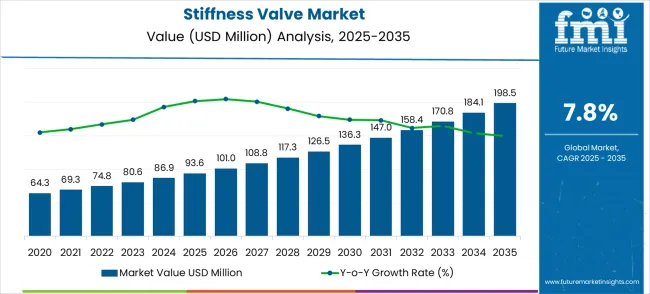
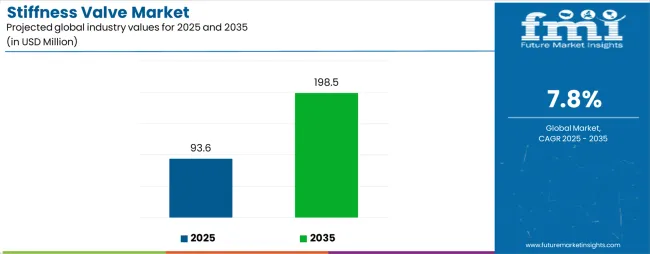
Between 2025 and 2030, the stiffness valve market is projected to expand from USD 93.6 million to USD 136.3 million, resulting in a value increase of USD 42.7 million, which represents 40.7% of the total forecast growth for the decade. This phase of growth will be shaped by rising penetration of advanced suspension technologies in commercial vehicles, increasing demand for adaptive damping systems, and growing adoption of intelligent suspension control mechanisms. Valve manufacturers are expanding their production capabilities to address the growing complexity of modern vehicle suspension requirements and performance optimization needs.
The stiffness valve market is segmented into automotive suspension systems at 41%, industrial machinery at 27%, construction equipment at 16%, aerospace applications at 10%, and specialty hydraulic systems at 6%. Automotive leads adoption, as stiffness valves provide adaptive damping, better ride quality, and improved vehicle stability. Industrial machinery integrates them for precise motion control, load management, and vibration reduction. Construction equipment relies on stiffness valves to maintain hydraulic performance under heavy loads and uneven terrain. Aerospace applications use valves in flight control and landing gear systems, while specialty hydraulic systems, including robotics and marine equipment, depend on them for reliable operation and safety under demanding conditions.
Key trends include electronically controlled valves, adaptive damping systems, and smart hydraulics for real-time performance adjustments. Manufacturers are developing lightweight, corrosion-resistant, and high-pressure valves. Adoption is expanding across automotive, industrial automation, and advanced construction machinery. Collaborations between valve producers and equipment manufacturers enable tailored solutions for load and performance needs. Focus on efficiency, reliability, and precise control continues to drive global market expansion.
| Stiffness Valve Market | Value |
|---|---|
| Market Value (2025) | USD 93.6 million |
| Market Forecast Value (2035) | USD 198.5 million |
| Market Forecast CAGR | 7.8% |
Market expansion is being supported by the rapid increase in automotive technology development worldwide and the corresponding need for high-performance suspension solutions that provide superior damping control capabilities and vehicle stability for advanced automotive applications. Modern commercial vehicles and passenger cars rely on consistent suspension performance and damping adaptability to ensure optimal ride comfort including heavy-duty trucks, luxury automobiles, and performance vehicles. Even minor suspension inefficiencies can require comprehensive vehicle adjustments to maintain optimal ride quality standards and handling performance.
The growing complexity of vehicle dynamics requirements and increasing demand for adaptive suspension solutions are driving demand for stiffness valves from certified manufacturers with appropriate performance capabilities and technical expertise. Automotive manufacturers are increasingly requiring documented performance specifications and reliability standards to maintain ride comfort quality and operational efficiency. Industry specifications and performance standards are establishing standardized suspension procedures that require specialized stiffness valve technologies and trained automotive installation personnel.
The rising awareness on vehicle comfort and performance optimization across commercial and passenger vehicle segments is creating substantial market opportunities for stiffness valve manufacturers. Advanced suspension systems incorporating intelligent damping control enable superior vehicle handling and ride quality compared to conventional fixed damping solutions. Automotive industry trends toward electrification and autonomous driving are further accelerating demand for sophisticated suspension control systems that require precise stiffness valve operation.
The market is segmented by valve type, application, and region. By valve type, the market is divided into mechanical stiffness valves, hydraulic stiffness valves, pneumatic stiffness valves, electrical stiffness valves, and electromagnetic stiffness valves. Based on application, the market is categorized into commercial vehicles, passenger vehicles. Regionally, the market is divided into North America, Europe, East Asia, South Asia & Pacific, Latin America, and Middle East & Africa.
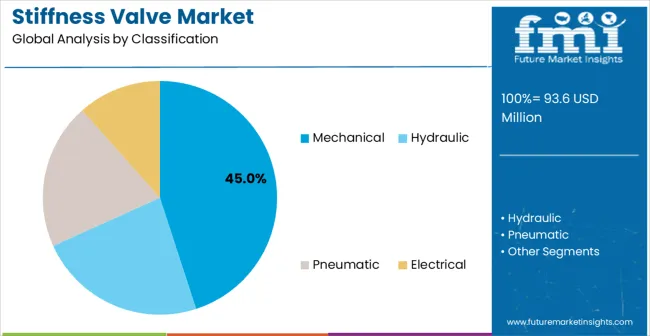
In 2025, the hydraulic stiffness valves segment is projected to capture around 45% of the total market share, making it the leading valve type category. This dominance is largely driven by the widespread adoption of hydraulic damping solutions that provide optimal balance between response time and damping force capability, catering to a wide variety of advanced automotive applications. Hydraulic stiffness valves are particularly favored for their ability to deliver superior damping precision and reliability in both commercial vehicle and passenger car installations, ensuring suspension performance and durability requirements. Commercial vehicle manufacturers, automotive OEMs, luxury car producers, and performance vehicle applications increasingly prefer this configuration, as it meets demanding suspension requirements without imposing excessive weight constraints or maintenance complexity.
The availability of well-established manufacturing processes, along with comprehensive technical support options and standardized hydraulic interfaces from leading suppliers, further reinforces the segment's market position. This valve type category benefits from consistent demand across regions, as it is considered a practical and reliable solution for vehicles requiring precise damping control and operational efficiency. The combination of damping precision, response characteristics, and installation flexibility makes hydraulic stiffness valves a dependable choice, ensuring their continued popularity in the automotive suspension and vehicle dynamics markets.
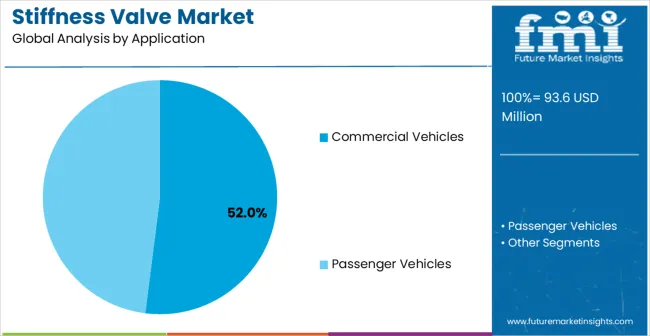
The commercial vehicles segment is expected to represent 52% of stiffness valves demand in 2025, highlighting its position as the most significant application sector. This dominance stems from the critical suspension requirements of modern commercial vehicle environments, where optimal ride comfort and load handling are essential to transportation efficiency and driver safety. Commercial vehicles often feature extensive suspension systems that demand specialized stiffness valves throughout complex chassis architectures, requiring reliable and high-performance damping solutions. Stiffness valves are particularly well-suited to these environments due to their ability to provide consistent damping performance and load adaptability, even during intensive cargo operations and varying road conditions. As logistics services expand globally and focus on improved performance standards, the demand for stiffness valves continues to rise.
The segment also benefits from heightened transportation efficiency requirements within the logistics industry, where operators are increasingly prioritizing suspension performance and ride comfort as essential operational measures. With commercial vehicles investing in advanced suspension systems and driver comfort standards, stiffness valves provide an essential component to maintain high-performance transportation services. The growth of e-commerce logistics and heavy-duty transportation, coupled with increased focus on driver wellness standards, ensures that commercial vehicles will remain the largest and most stable demand driver for stiffness valves in the forecast period.
The stiffness valve market is advancing rapidly due to increasing automotive technology development and growing recognition of advanced suspension advantages over traditional fixed damping solutions in high-performance applications. The market faces challenges including higher initial costs compared to conventional suspension alternatives, need for specialized installation and maintenance expertise, and complex compatibility requirements with existing vehicle systems across different automotive platforms. Performance optimization efforts and advanced valve technology programs continue to influence equipment development and market adoption patterns.
The growing development of intelligent suspension systems and enhanced damping control mechanisms is enabling superior ride comfort with improved vehicle stability and reduced vibration transmission. Advanced suspension technologies and optimized valve designs provide superior damping performance while maintaining installation flexibility requirements. These technologies are particularly valuable for automotive manufacturers who require reliable suspension performance that can support extensive vehicle operation with consistent high-quality results.
Modern stiffness valve manufacturers are incorporating advanced vehicle monitoring capabilities and intelligent suspension systems that enhance ride performance and operational effectiveness. Integration of smart damping technologies and optimized suspension management systems enables superior vehicle optimization and comprehensive dynamics management capabilities. Advanced suspension features support operation in diverse automotive environments while meeting various performance requirements and handling specifications.
The Stiffness Valve market is entering a new phase of growth, driven by demand for enhanced suspension performance, automotive technology advancement, and evolving comfort and safety standards. By 2035, these pathways together can unlock USD 35-45 million in incremental revenue opportunities beyond baseline growth.
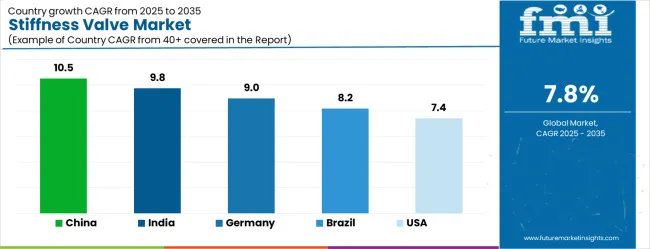
| Country | CAGR (2025-2035) |
|---|---|
| China | 10.5% |
| India | 9.8% |
| Germany | 9.0% |
| Brazil | 8.2% |
| United States | 7.4% |
| United Kingdom | 6.6% |
| Japan | 5.9% |
The stiffness valve market is growing rapidly, with China leading at a 10.5% CAGR through 2035, driven by massive automotive production expansion and increasing adoption of advanced suspension solutions. India follows at 9.8%, supported by rising commercial vehicle manufacturing and growing awareness of suspension performance benefits. Germany grows strongly at 9.0%, integrating advanced suspension technology into its established automotive industry. Brazil records 8.2%, prioritizing automotive sector modernization and suspension upgrade initiatives. The United States shows solid growth at 7.4%, focusing on commercial vehicle fleet expansion and suspension optimization. The United Kingdom demonstrates steady progress at 6.6%, maintaining established automotive applications. Japan records 5.9% growth, concentrating on technology advancement and suspension efficiency optimization.
The report covers an in-depth analysis of 40+ countries, Top-performing countries are highlighted below.
The demand of stiffness valves in China is projected to exhibit the highest growth rate with a CAGR of 10.5% through 2035, driven by unprecedented expansion of automotive manufacturing and increasing demand for advanced suspension solutions. The country's massive automotive sector and expanding commercial vehicle production are creating enormous demand for sophisticated stiffness valve solutions. Major automotive manufacturers are establishing comprehensive suspension systems to support the increasing requirements of logistics companies and passenger vehicle facilities across metropolitan regions.
Government automotive development initiatives are supporting establishment of smart manufacturing facilities and advanced automotive complexes, driving demand for high-performance stiffness valves throughout major industrial zones. Automotive sector modernization programs are facilitating adoption of advanced suspension technologies that enhance vehicle performance and ride comfort standards across commercial vehicle networks.
The stiffness valves market in India is expanding at a CAGR of 9.8%, supported by increasing commercial vehicle sector development and growing awareness of advanced suspension benefits. The country's expanding automotive industry and rising vehicle performance standards are driving demand for sophisticated stiffness valve solutions. Commercial vehicle manufacturers and automotive facilities are gradually implementing high-performance suspension equipment to maintain competitive standards and operational efficiency.
Automotive sector growth and commercial vehicle development are creating opportunities for suppliers that can support diverse vehicle requirements and performance specifications. Professional training and technical programs are building expertise among automotive installation personnel, enabling effective utilization of stiffness valve technology that meets automotive standards and suspension requirements.
Demand for stiffness valves in Germany is projected to grow at a CAGR of 9.0%, supported by the country's focus on automotive engineering quality standards and advanced suspension technology adoption. German automotive facilities are implementing sophisticated suspension systems that meet stringent performance requirements and operational specifications. The market is characterized by focus on vehicle reliability, suspension excellence, and compliance with comprehensive automotive standards.
Automotive industry investments are prioritizing cutting-edge suspension technology that demonstrates superior performance and reliability while meeting German quality and efficiency standards. Professional certification programs are ensuring comprehensive technical expertise among automotive personnel, enabling specialized suspension capabilities that support diverse vehicle applications and facility requirements.
The stiffness valves market in Brazil is growing at a CAGR of 8.2%, driven by increasing automotive sector development and growing recognition of advanced suspension advantages. The country's expanding automotive industry is gradually integrating sophisticated suspension solutions to enhance vehicle performance and service quality. Automotive facilities and commercial vehicle manufacturers are investing in suspension technology to address evolving performance requirements and competitive pressures.
Automotive modernization is facilitating adoption of advanced suspension technologies that support comprehensive vehicle capabilities across automotive regions. Professional development programs are enhancing technical capabilities among automotive personnel, enabling effective stiffness valve utilization that meets evolving automotive standards and performance requirements.
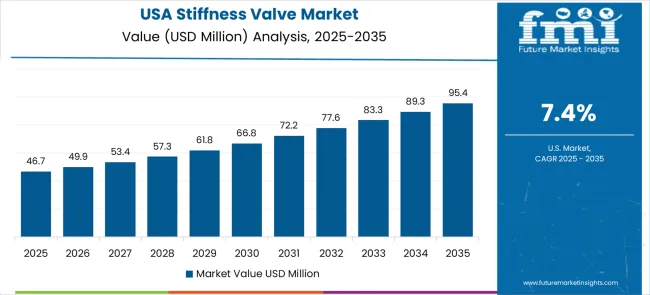
Demand for stiffness valves in the U.S. is expanding at a CAGR of 7.4%, driven by established automotive industries and growing focus on suspension performance enhancement. Large automotive companies and commercial vehicle providers are implementing comprehensive stiffness valve capabilities to serve diverse suspension requirements. The market benefits from established automotive distribution systems and professional development programs that support various vehicle applications.
Automotive industry leadership is enabling standardized suspension utilization across multiple vehicle types, providing consistent performance standards and comprehensive suspension coverage throughout regional markets. Professional development and certification programs are building specialized technical expertise among automotive personnel, enabling effective stiffness valve utilization that supports evolving vehicle facility requirements.
Demand for stiffness valves in the U.K. is projected to grow at a CAGR of 6.6%, supported by established automotive sectors and growing focus on suspension performance capabilities. British automotive facilities and vehicle service providers are implementing stiffness valve systems that meet industry performance standards and operational requirements. The market benefits from established automotive infrastructure and comprehensive training programs for technical professionals.
Automotive facility investments are prioritizing advanced suspension solutions that support diverse vehicle applications while maintaining established performance and reliability standards. Professional development programs are building technical expertise among automotive personnel, enabling specialized stiffness valve operation capabilities that meet evolving facility requirements and performance standards.
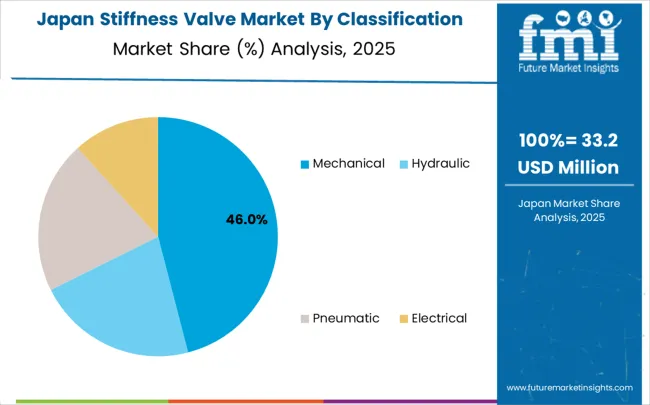
The stiffness valves market in Japan is growing at a CAGR of 5.9%, driven by the country's focus on automotive technology innovation and suspension enhancement applications. Japanese automotive facilities are implementing advanced stiffness valve systems that demonstrate superior performance reliability and operational consistency. The market is characterized by focus on technological excellence, quality assurance, and integration with established automotive workflows.
Automotive technology investments are prioritizing innovative suspension solutions that combine advanced stiffness valve technology with precision engineering while maintaining Japanese quality and reliability standards. Professional development programs are ensuring comprehensive technical expertise among automotive personnel, enabling specialized suspension capabilities that support diverse automotive applications and facility requirements.
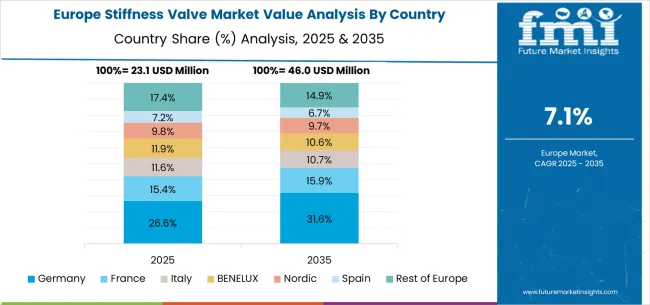
The stiffness valve market in Europe is forecast to expand from USD 24.2 million in 2025 to USD 51.8 million by 2035, registering a CAGR of 7.9%. Germany will remain the largest market, holding 32.1% share in 2025, easing to 31.8% by 2035, supported by strong automotive infrastructure and advanced suspension standards. The United Kingdom follows, rising from 24.3% in 2025 to 24.6% by 2035, driven by automotive facility modernization and suspension enhancement initiatives. France is expected to maintain stability from 18.2% to 18.0%, reflecting consistent automotive industry investments and suspension requirements. Italy holds around 14.1% throughout the forecast period, supported by automotive facility upgrades and vehicle infrastructure modernization programs. Spain grows from 6.8% to 7.2% with expanding automotive infrastructure and increased focus on advanced suspension solutions. BENELUX markets maintain 3.1% to 2.9%, while the remainder of Europe hovers near 1.4%--1.5%, balancing emerging Eastern European automotive development against mature Nordic markets with established suspension technology adoption patterns.
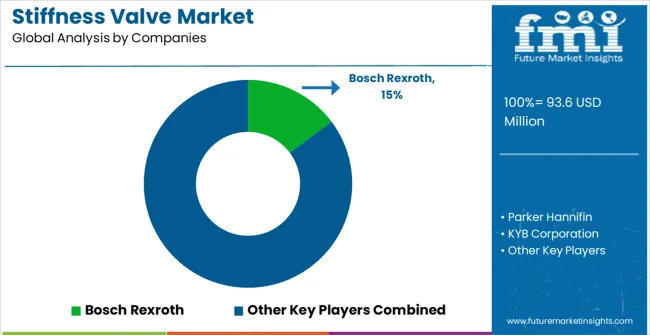
The stiffness valve market is defined by competition among specialized automotive component manufacturers, suspension system companies, and vehicle dynamics solution providers. Companies are investing in advanced valve technology development, damping innovation, suspension performance optimization, and comprehensive installation service capabilities to deliver reliable, high-performance, and cost-effective suspension solutions. Strategic partnerships, technological innovation, and market expansion are central to strengthening product portfolios and market presence.
Bosch Rexroth offers comprehensive automotive solutions with established manufacturing expertise and professional-grade suspension capabilities. Parker Hannifin provides specialized hydraulic equipment with focus on damping reliability and operational performance. KYB Corporation delivers advanced suspension solutions with focus on performance efficiency and vehicle-friendly operation. ZF Friedrichshafen specializes in automotive technology with advanced manufacturing integration.
Continental AG offers professional-grade automotive equipment with comprehensive technical support capabilities. Japhl Powertrain delivers established suspension solutions with advanced damping technologies. ELI Electromagnetic Technology provides specialized valve equipment with focus on performance optimization. Anhore High-tech, Hefa Science and Technology, Tuopu Group, and Cheersson Precision Metal Forming offer specialized manufacturing expertise, product reliability, and comprehensive development across global and regional automotive market segments.
| Item | Value |
|---|---|
| Quantitative Units | USD 93.6 million |
| Valve Type | Mechanical Stiffness Valves, Hydraulic Stiffness Valves, Pneumatic Stiffness Valves, Electrical Stiffness Valves, Electromagnetic Stiffness Valves |
| Application | Commercial Vehicles, Passenger Vehicles, Other |
| Regions Covered | North America, Europe, East Asia, South Asia & Pacific, Latin America, Middle East & Africa |
| Country Covered | China, India, Germany, Brazil, United States, United Kingdom, Japan, and 40+ countries |
| Key Companies Profiled | Bosch Rexroth, Parker Hannifin, KYB Corporation, ZF Friedrichshafen, Continental AG, Japhl Powertrain, ELI Electromagnetic Technology, Anhore High-tech, Hefa Science and Technology, Tuopu Group, Cheersson Precision Metal Forming |
| Additional Attributes | Dollar sales by valve type and application segment, regional demand trends across major markets, competitive landscape with established automotive manufacturers and emerging suspension providers, customer preferences for different valve configurations and performance options, integration with vehicle suspension systems and automotive protocols, innovations in damping technology and valve efficiency, and adoption of intelligent design features with enhanced performance capabilities for improved suspension workflows. |
The global filling and sealing machine market is estimated to be valued at USD 2,327.9 million in 2025.
The market size for the filling and sealing machine market is projected to reach USD 3,189.7 million by 2035.
The filling and sealing machine market is expected to grow at a 3.2% CAGR between 2025 and 2035.
The key product types in filling and sealing machine market are fully-automatic and semi-automatic.
In terms of application, food and beverages segment to command 47.0% share in the filling and sealing machine market in 2025.






Our Research Products

The "Full Research Suite" delivers actionable market intel, deep dives on markets or technologies, so clients act faster, cut risk, and unlock growth.

The Leaderboard benchmarks and ranks top vendors, classifying them as Established Leaders, Leading Challengers, or Disruptors & Challengers.

Locates where complements amplify value and substitutes erode it, forecasting net impact by horizon

We deliver granular, decision-grade intel: market sizing, 5-year forecasts, pricing, adoption, usage, revenue, and operational KPIs—plus competitor tracking, regulation, and value chains—across 60 countries broadly.

Spot the shifts before they hit your P&L. We track inflection points, adoption curves, pricing moves, and ecosystem plays to show where demand is heading, why it is changing, and what to do next across high-growth markets and disruptive tech

Real-time reads of user behavior. We track shifting priorities, perceptions of today’s and next-gen services, and provider experience, then pace how fast tech moves from trial to adoption, blending buyer, consumer, and channel inputs with social signals (#WhySwitch, #UX).

Partner with our analyst team to build a custom report designed around your business priorities. From analysing market trends to assessing competitors or crafting bespoke datasets, we tailor insights to your needs.
Supplier Intelligence
Discovery & Profiling
Capacity & Footprint
Performance & Risk
Compliance & Governance
Commercial Readiness
Who Supplies Whom
Scorecards & Shortlists
Playbooks & Docs
Category Intelligence
Definition & Scope
Demand & Use Cases
Cost Drivers
Market Structure
Supply Chain Map
Trade & Policy
Operating Norms
Deliverables
Buyer Intelligence
Account Basics
Spend & Scope
Procurement Model
Vendor Requirements
Terms & Policies
Entry Strategy
Pain Points & Triggers
Outputs
Pricing Analysis
Benchmarks
Trends
Should-Cost
Indexation
Landed Cost
Commercial Terms
Deliverables
Brand Analysis
Positioning & Value Prop
Share & Presence
Customer Evidence
Go-to-Market
Digital & Reputation
Compliance & Trust
KPIs & Gaps
Outputs
Full Research Suite comprises of:
Market outlook & trends analysis
Interviews & case studies
Strategic recommendations
Vendor profiles & capabilities analysis
5-year forecasts
8 regions and 60+ country-level data splits
Market segment data splits
12 months of continuous data updates
DELIVERED AS:
PDF EXCEL ONLINE
Valve Grinder Market Size and Share Forecast Outlook 2025 to 2035
Valve Seat Inserts Market Size and Share Forecast Outlook 2025 to 2035
Valve Driver Market Size and Share Forecast Outlook 2025 to 2035
Valve Remote Control Systems Market Analysis by Type, Application and Region - Forecast for 2025 to 2035
Valve Positioner Market Growth – Trends & Forecast (2024-2034)
Valve Cover Gasket Market
Valve Sack Market
ESD Valve Market Forecast and Outlook 2025 to 2035
EGR Valve Market
HVAC Valve Market Size and Share Forecast Outlook 2025 to 2035
Flat Valve Caps And Closures Market Size and Share Forecast Outlook 2025 to 2035
Gate Valve Market Growth – Trends & Forecast 2023-2033
Korea Valve Seat Insert Market Trend Analysis Based on Sales, Material, Engine, End-Use, and Provinces 2025 to 2035
Japan Valve Seat Inserts Market Trend Analysis Based on Sales Channel, Material, Engine, End-Use and Provinces 2025 to 2035
Lined Valve Market Growth – Trends & Forecast 2024-2034
Remote Valve Tissue Expanders Market Size and Share Forecast Outlook 2025 to 2035
Bag On Valve Product Market Size and Share Forecast Outlook 2025 to 2035
Engine Valve Market Size and Share Forecast Outlook 2025 to 2035
Pasted Valve Bags Market Size and Share Forecast Outlook 2025 to 2035
Slurry Valves Market Analysis - Size, Share, and Forecast 2025 to 2035

Thank you!
You will receive an email from our Business Development Manager. Please be sure to check your SPAM/JUNK folder too.
Chat With
MaRIA